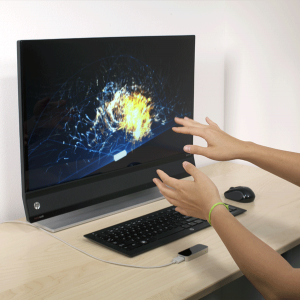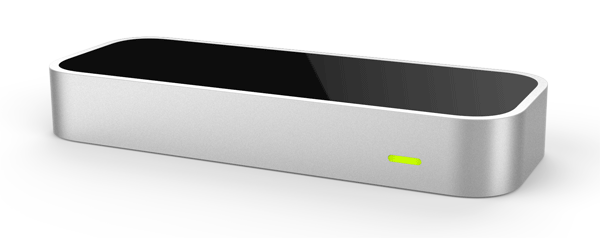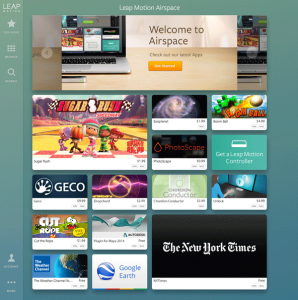 You have probably seen many different science fiction movies where the characters use their hands in mid-air to control computers and other devices. The technology has been around for a while now in consoles thanks to the Kinect on the XBox consoles but what about current computer systems? Many of them have web cameras built into them but only a few out there offer motion controls that they are extremely limited even compared to the Kinect. HP has recently announced that it is based upon technology created by Leap Motion. This same technology can actually be used with any Windows or Mac based computer through a small $80 device. Does such an inexpensive peripheral device really provide a completely new user experience?
You have probably seen many different science fiction movies where the characters use their hands in mid-air to control computers and other devices. The technology has been around for a while now in consoles thanks to the Kinect on the XBox consoles but what about current computer systems? Many of them have web cameras built into them but only a few out there offer motion controls that they are extremely limited even compared to the Kinect. HP has recently announced that it is based upon technology created by Leap Motion. This same technology can actually be used with any Windows or Mac based computer through a small $80 device. Does such an inexpensive peripheral device really provide a completely new user experience?
The Leap Motion Controller Hardware
 For its capabilities, the Leap Motion Controller is a very small device that is probably smaller than your typical mouse. The bar is roughly three inches long and one inch wide and a bit thicker than a smartphone. The top of the device has a black glossy surface that hides the various sensors used to read the position of your hands when the device is in use. There is just a single port on the side for a USB cable that then plugs into your Mac or PC. A two foot and five foot cable is supplied for use with either a laptop computer or a desktop system.
For its capabilities, the Leap Motion Controller is a very small device that is probably smaller than your typical mouse. The bar is roughly three inches long and one inch wide and a bit thicker than a smartphone. The top of the device has a black glossy surface that hides the various sensors used to read the position of your hands when the device is in use. There is just a single port on the side for a USB cable that then plugs into your Mac or PC. A two foot and five foot cable is supplied for use with either a laptop computer or a desktop system.
For being such a small device, it actually offers a pretty incredible level of detail. The device can track all ten fingers on the two hands of the user including their orientation and height and do so quite quickly. This means that the device can actually support a high level of detail for fine motion control within the software. The downside is that the tracking area is quite small. While the Kinect on the XBox tracks an entire room, the Leap Motion Controller only looks at an area directly above and just around the device in a two foot radius. Leap estimates this to be about a eight cubic foot area of space.
The Motion Software
Of course the Leap Motion Controller is only as useful as the software that is provided with it or designed to work with it. If you were hoping to use the Leap Motion in place of a mouse or trackpad, you can pretty much forget about it. The reason is that it is almost like having to hold a pen up in front of the screen. Doing so is often awkward as you have to move your finger or hand toward the screen to simulate touching it. In essence, imagine that you have a touch screen but aren’t touching it. Since many new laptops in particular have a touchscreen to deal with Windows 8 new UI, the feature is less useful as a pointer replacement.
 So to really make use of the Leap Motion Controller, you need to use software outside of the controller suite. At this point, there are only around 150 total applications split between the two OS platforms and available through Leap’s . The majority of these applications are games and entertainment. Some of the applications function extremely well with a high level of detail but others feel very much like beta programs with limited input capabilities or the tracking seemed off.
So to really make use of the Leap Motion Controller, you need to use software outside of the controller suite. At this point, there are only around 150 total applications split between the two OS platforms and available through Leap’s . The majority of these applications are games and entertainment. Some of the applications function extremely well with a high level of detail but others feel very much like beta programs with limited input capabilities or the tracking seemed off.
Conclusions
At this point, the Leap Motion Controller is more a fun diversion for computer users than a full tool. Some of the games are entertaining but keeping ones hands upon in the air over the sensors can get tiring if you are using the programs for extended periods of time. In addition, many of the creative applications can be done just as well through other devices such as a Wacom digitizer. If you really want to consider adding the device to your PC, I highly recommend that you browse through the available programs in the Airspace Store before buying the device to see if there are enough programs of interest to justify the purchase of the hardware plus any of software you intend to use with it.

Pingback: Will the Intel RealSense Technology Really Change Computing? - Tech for Anyone